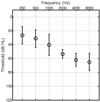Effects of expansion on consonant recognition and consonant audibility
- PMID: 19927675
- PMCID: PMC2784644
- DOI: 10.3766/jaaa.20.2.5
Effects of expansion on consonant recognition and consonant audibility
Erratum in
- J Am Acad Audiol. 2009 Nov-Dec;20(10):658
Abstract
Background: Hearing aid expansion is intended to reduce the gain for low-level noise. However, expansion can also degrade low-intensity speech. Although it has been suggested that the poorer performance with expansion is due to reduced audibility, this has not been measured directly. Furthermore, previous studies used relatively high expansion kneepoints.
Purpose: This study compared the effect of a 30 dB SPL and 50 dB SPL expansion kneepoint on consonant audibility and recognition.
Research design: Eight consonant-vowel syllables were presented at 50, 60, and 71 dB SPL. Recordings near the tympanic membrane were made of each speech token and used to calculate the Aided Audibility Index (AAI).
Study sample: Thirteen subjects with mild to moderate sensorineural hearing loss.
Results: Expansion with a high kneepoint resulted in reduced consonant recognition. The AAI correlated significantly with consonant recognition across all conditions and subjects.
Conclusion: If consonant recognition is the priority, audibility calculations could be used to determine an optimal expansion kneepoint for a given individual.
Figures






Similar articles
-
Effects of audibility and multichannel wide dynamic range compression on consonant recognition for listeners with severe hearing loss.Ear Hear. 2009 Oct;30(5):494-504. doi: 10.1097/AUD.0b013e3181aec5bc. Ear Hear. 2009. PMID: 19633563 Free PMC article.
-
Evaluation of wideband frequency responses and nonlinear frequency compression for children with cookie-bite audiometric configurations.J Am Acad Audiol. 2014 Nov-Dec;25(10):1022-33. doi: 10.3766/jaaa.25.10.10. J Am Acad Audiol. 2014. PMID: 25514454
-
The role of consonant-vowel amplitude ratio in the recognition of voiceless stop consonants by listeners with hearing impairment.J Speech Lang Hear Res. 1999 Feb;42(1):42-55. doi: 10.1044/jslhr.4201.42. J Speech Lang Hear Res. 1999. PMID: 10025542
-
Spatial separation benefit for unaided and aided listening.Ear Hear. 2014 Jan-Feb;35(1):72-85. doi: 10.1097/AUD.0b013e3182a02274. Ear Hear. 2014. PMID: 24121648 Free PMC article.
-
Improving speech audibility with wide dynamic range compression in listeners with severe sensorineural loss.Ear Hear. 1999 Dec;20(6):461-70. doi: 10.1097/00003446-199912000-00002. Ear Hear. 1999. PMID: 10613384
Cited by
-
Influence of Audibility and Distortion on Recognition of Reverberant Speech for Children and Adults with Hearing Aid Amplification.J Am Acad Audiol. 2022 Mar;33(3):170-180. doi: 10.1055/a-1678-3381. Epub 2021 Oct 25. J Am Acad Audiol. 2022. PMID: 34695870 Free PMC article.
-
Audibility and Spectral-Ripple Discrimination Thresholds as Predictors of Word Recognition with Nonlinear Frequency Compression.J Am Acad Audiol. 2021 Oct;32(9):596-605. doi: 10.1055/s-0041-1732333. Epub 2022 Feb 17. J Am Acad Audiol. 2021. PMID: 35176803 Free PMC article.
-
Perceptual Implications of Level- and Frequency-Specific Deviations from Hearing Aid Prescription in Children.J Am Acad Audiol. 2017 Oct;28(9):861-875. doi: 10.3766/jaaa.17014. J Am Acad Audiol. 2017. PMID: 28972473 Free PMC article.
-
Influence of Instantaneous Compression on Recognition of Speech in Noise with Temporal Dips.J Am Acad Audiol. 2019 Jan;30(1):16-30. doi: 10.3766/jaaa.16165. Epub 2017 Dec 15. J Am Acad Audiol. 2019. PMID: 30461387 Free PMC article.
-
Temporal resolution with a prescriptive fitting formula.Am J Audiol. 2013 Dec;22(2):216-25. doi: 10.1044/1059-0889(2013/13-0001). Am J Audiol. 2013. PMID: 23824436 Free PMC article.
References
-
- American National Standards Institute. Specifications of Hearing Aid Characteristics (ANSI S3.22-1996) New York: American National Standards Institute; 1996.
-
- American National Standards Institute. American National Standard Methods for the Calculation of the Articulation Index (ANSI S3.5-1997) New York: American National Standards Institute; 1997.
-
- American National Standards Institute. American National Standard Maximum Permissible Ambient Noise Levels for Audiometric Test Rooms (ANSI S3.1-1999) New York: American National Standards Institute; 1999.
-
- Boike KT, Souza PE. Effect of compression ratio on speech recognition and speech-quality ratings with wide dynamic range compression amplification. J Speech Lang Hear Res. 2000;43:456–468. - PubMed
-
- Boothroyd A, Erickson FN, Medwetsky L. The hearing aid input: a phonemic approach to assessing the spectral distribution of speech. Ear Hear. 1994;15:432–442. - PubMed
Publication types
MeSH terms
Grants and funding
LinkOut - more resources
Full Text Sources
Medical
Miscellaneous
